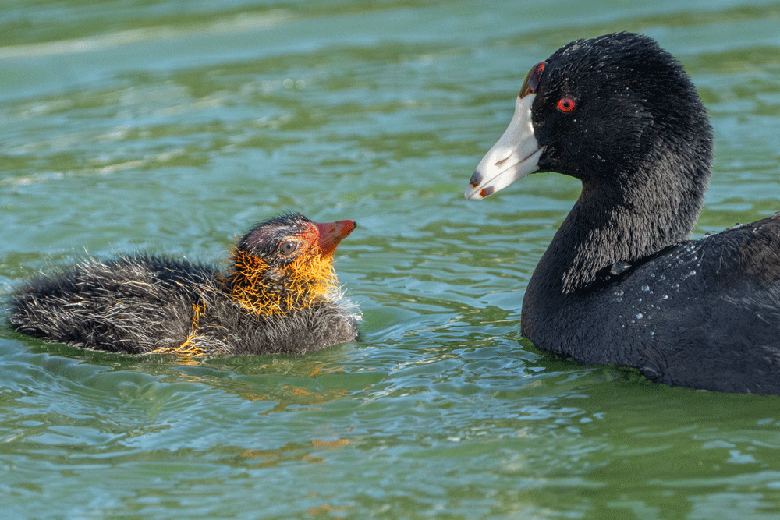
by Karen Telleen-Lawton, Noozhawk Columnist, read original in Noozhawk here.
March 24, 2025 | 3:00 pm
After two plastic-bashing columns (Plastic is Permanent Pollution and Plastic Part II Solutions), I’ll wrap up this little series with some beneficial uses of plastics.

An American coot parent with downy gray chick at Lake Los Carneros. (Sophie Cameron photo)
The idea emerged courtesy of bird ingenuity – coots in the Netherlands, specifically.
Common coots are wetland birds familiar in marshes around the globe. They are resourceful in finding common objects for use in nest-building.
Since 79 percent of all the plastic that has ever been produced is still around, it is highly available for nest material.
Many bird species, including coots, began incorporating plastic in their nests in the early 1990s. Recently, researchers in the Netherlands found an urban population of common coots in which every single nest contained plastic.
Until the Anthropocene, coots exclusively used plant materials, rebuilding their nests each year. With the introduction of plastic, coots have altered their behavior, reusing their nests year to year.
This behavioral change has allowed researchers to use the stratigraphy of plastic debris to create a history of multiple years of nest use, reuse and reconstruction.
One nest, for example, contained 635 artificial items. A third were food-related, and 5% of those included an expiration date. Recent layers included face masks. Fully half the dateable products in this nest were from McDonald’s.
The reuse of nests in a species that previously constructed single-season nests poses potential disadvantages for the birds. Nest reuse can spread disease or increase predation.
Nevertheless, coots may use the building time saved for more activity in territorial defense or breeding activity. As a species, the “permanent nest” behavior seems to allow the coots to nest further into urban areas, where plant material is harder to find.
All these potential changed behaviors are important for scientists analyzing climate disruption.
Plastic, thus, has been a boon to common loons and loon researchers. More broadly, the beneficial properties of plastics have exploded their development and use in the last half century.
They have driven extensive improvements in packaging, transportation, health care, and construction, to name a few.
In packaging, the containers can deform flexibly to fit, providing a quality and freshness seal that can be superior and longer lasting than alternatives. They weigh less than glass or metal, reducing energy use and transportation costs.
In the transportation field, plastic in many components of vehicles reduces their weight, improving fuel efficiency. As an alternative to steel, plastic also resists corrosion.
Plastics have become essential in healthcare and medical devices. They have generally thought to be easy to clean and sterilize, although it is now becoming apparent that bacteria can survive on plastic surfaces longer than on porous surfaces. Bacteria on plastic can survive from a few days to even months.
In construction, plastics have improved the durability and water resistance in everything from roofing materials to protective gear.
Plastics are less subject to moisture and rot. They have largely replaced many household items including storage and cleaning containers.
Plastic cooking tools were in common use before cooks understood that they leach chemicals into food.
Plastics manufacturers have designed creative, innovative and even ingenious solutions that save time, resources and lives.
What they haven’t done is to consider the whole life of their products, an essential element of the Precautionary Principle.
Plastics require 20-500 years to decompose. Even then, the decomposed components become micro- and nano-plastics, contaminating wildlife, nature, and our bodies.
Ever ingenious, scientists worldwide are researching next-generation plastics. Several areas of interest include bio-degrable plastic, locating bacteria that will break down plastic; and bioengineering such bacteria.
In Japan, bacteria was discovered in 2001 growing on plastic consumer items. Ideonella sakaiensis can break down PET, a common plastic used in drink bottles.
In the U.S., Northwestern University researchers are investigating another common group of bacteria called Comamonas found in wastewater systems and urban rivers.
These bacteria use carbon from plastic for food. They secrete an enzyme to break down nano plastics.
Research is just gearing up around the world, but in the United States 44% of research is conducted at universities.
Problematically, these are being targeted by the current administration. Vice President JD Vance declared professors to be “the enemy.” Federal research funding is being slashed and dismantled.
As American leadership and innovation are being ceded to other countries, we will have to import their inventions and superior products. But tariffs will become a problem for importing new technology.
Oops, this was supposed to be a hopeful column. Maybe hope is for the birds.

Karen Telleen-Lawton is an eco-writer, sharing information and insights about economics and ecology, finances and the environment. Having recently retired from financial planning and advising, she spends more time exploring the outdoors — and reading and writing about it. The opinions expressed are her own.


